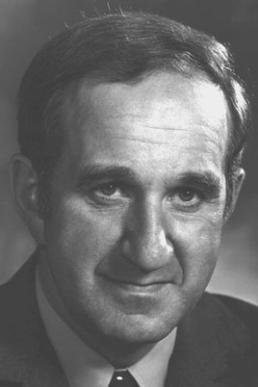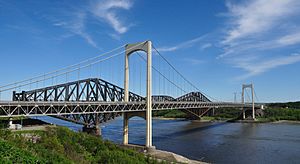Pierre Laporte facts for kids
Quick facts for kids
Pierre Laporte
|
|
|---|---|
 |
|
| Deputy Premier of Quebec | |
| In office April – October 1970 |
|
| Premier | Robert Bourassa |
| Preceded by | Jean-Guy Cardinal (1970) |
| Succeeded by | Gérard D. Levesque (1972) |
| Member of the National Assembly of Quebec for Chambly | |
| In office 1961–1970 |
|
| Preceded by | Robert Théberge |
| Succeeded by | Jean Cournoyer |
| Personal details | |
| Born | 25 February 1921 Montreal, Quebec, Canada |
| Died | 17 October 1970 (aged 49) Quebec |
| Resting place | Notre Dame des Neiges Cemetery |
| Political party | Liberal |
| Spouse | Françoise Brouillet (30 Jan 1923 - 2 Nov 2021) |
Pierre Laporte (born February 25, 1921 – died October 17, 1970) was a Canadian lawyer, journalist, and politician. He served as the Deputy Premier of the province of Quebec. Sadly, he was kidnapped and murdered by a group called the Front de libération du Québec (FLQ) during a difficult time known as the October Crisis.
Contents
Early Life and Career
Pierre Laporte was born in Montreal, Quebec, on February 25, 1921. He came from a family with a history in politics.
A Journalist Who Spoke Out
From 1945 to 1961, Pierre Laporte worked as a journalist for the newspaper Le Devoir. He was known for his brave reporting against the government of Quebec's Premier, Maurice Duplessis. He studied law and graduated from the Université de Montreal in 1950.
During his time as a journalist, he wrote many articles that questioned how the government was being run. He was a pioneer in what is called "investigative journalism." This means he dug deep to uncover important facts and share them with the public. One person who knew him said he was "very courageous."
Entering Politics
After Premier Duplessis passed away, Pierre Laporte decided to enter politics. He successfully ran for the Quebec Liberal Party in the area of Chambly. He became a member of the Quebec National Assembly in 1961.
He was a key member of the Liberal Party and served in the government of Premier Jean Lesage. Pierre Laporte held important roles, including Minister of Municipal Affairs from 1962 to 1966. He also served as Minister of Cultural Affairs from 1964 to 1966. In 1965, he helped create the city of Laval by merging several smaller towns.
Pierre Laporte often spoke up for ordinary people. He believed that the government needed to look after the interests of "average men." In 1969, when Premier Lesage decided to step down, Laporte ran to become the new leader of the Quebec Liberal Party. However, he lost the leadership election to Robert Bourassa.
After the 1970 Quebec general election, Premier Bourassa appointed Pierre Laporte to several important positions. He became the Deputy Premier, the Parliamentary Leader, the Minister of Immigration, and the Minister of Labour and Manpower.
Kidnapping and Murder
On October 5, 1970, another person, James Cross, who was a British trade official, was kidnapped in Montreal by the FLQ. Pierre Laporte described this event as "a wind of madness temporarily blowing across Canada."
The Kidnapping
Just five days later, on October 10, 1970, Pierre Laporte himself was kidnapped. He was at his home in Saint-Lambert, Quebec, playing football with his nephew when members of the Chénier Cell of the FLQ forced him into their car at gunpoint.
The FLQ chose Laporte because he did not have bodyguards, making him an easier target. They called him the "Minister of Unemployment and Assimilation." They held him hostage and demanded that 23 "political prisoners" be released in exchange for his freedom.
Pierre Laporte was held in a house in Longueuil. During this tense time, the Prime Minister of Canada, Pierre Trudeau, used the War Measures Act. This law allowed police to conduct many searches and arrests to find the kidnappers and the hostages.
His Death
On the afternoon of October 16, 1970, Pierre Laporte heard a police siren nearby and tried to escape through a window. He broke the window but was injured. The next morning, on October 17, his captors killed him.
Pierre Laporte was buried on October 20, 1970, at the Cimetière Notre-Dame-des-Neiges in Montreal. Many important people from both Ottawa and Quebec City attended his funeral.
Aftermath
The members of the Chénier Cell were arrested by the Sûreté du Québec on December 28, 1970. They were found at a farmhouse south of Montreal. The people involved in the kidnapping and murder received prison sentences.
Years later, in 1977, a book was published that suggested a conspiracy theory about Laporte's death. However, this theory was proven wrong in 1982 when a book written by the four members of the Chénier Cell stated that they were all responsible for Laporte's murder.
In 2010, a documentary suggested that Pierre Laporte's death was not planned but happened in a moment of panic.
Monument to Laporte
On October 17, 2010, which was the 40th anniversary of his death, a monument was revealed in honor of Pierre Laporte. The Premier of Quebec at the time, Jean Charest, unveiled it. The monument is located at the St. Lawrence Seaway Park, close to where Laporte lived.
The monument has a special message carved into it: "Nul ne vit pour soi-même. Nul ne meurt pour soi-même." This means "No one lives for oneself. No one dies for oneself."
A middle school in Toronto, Ontario, is also named after Pierre Laporte to remember him.
See also
- List of kidnappings
- List of solved missing person cases


